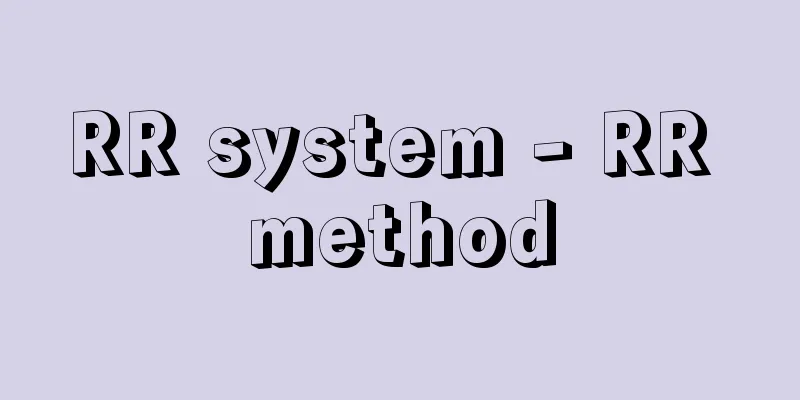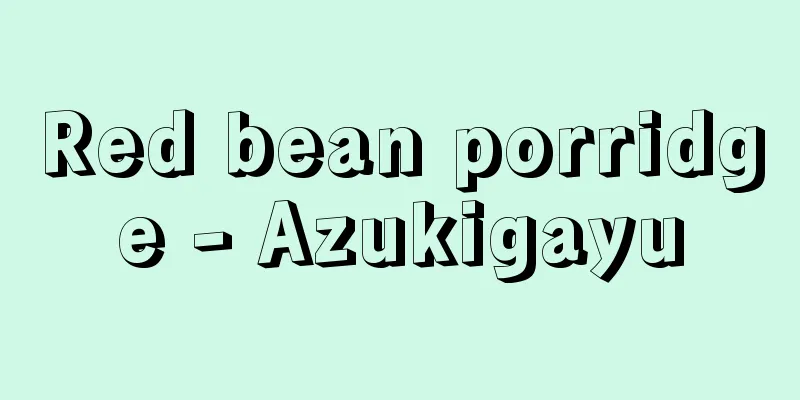Tropism

|
This refers to the directional movement of a plant's organs in response to an external stimulus that is related to the direction of the stimulus. Bending in the direction of the stimulus is called positive tropism, while bending in the opposite direction to the stimulus is called negative tropism. Bending at an angle to the direction of the stimulus is called obliquity tropism, and when the angle is a right angle it is called lateral or lateral tropism. Depending on the type of stimulus, it is called phototropism, geotropism, tropism, etc. Since a tropic response is generally a type of growth response that occurs due to the difference in growth rate between the stimulated side and the opposite side, it takes time for a response to be observed after the stimulus is applied. [Masayuki Katsumi] PhototropismThis is also called phototropism. When light is irradiated from one side, shoots, coleoptiles (young shoots) of grasses, and sporangiophores of Phycomyces show positive phototropism (sun-seeking). Roots either do not show phototropism or show negative phototropism, but some, such as onion roots, show positive phototropism. The leaves of many plants generally show lateral phototropism (lateral sun-seeking), in which the leaf blade moves at a right angle to the incident light. The arrangement of leaves in relation to the direction of light is thought to have ecological significance in relation to sunlight. The light-sensitive parts of stems and roots are the tips, and of leaves, the entire leaf including the blade or petiole. Phototropism has been studied in detail in the coleoptiles of grasses. When the tip of the coleoptile receives lateral light stimulation, auxin produced at the tip and transported downward becomes unevenly distributed, with more on the side not exposed to light. This causes growth there to be greater than on the side exposed to light, and the distortion of growth causes bending. In this way, it is thought that the phototropic response occurs via plant hormones. [Masayuki Katsumi] GeotropismAlso called gravitropism. Stems and other above-ground parts of plants and fungal sporangia show negative geotropism (anteroposterior geotropism), while roots show positive geotropism (geotropism). If a sprouting plant is placed on its side, the stem will rise up and bend in the opposite direction to gravity, while the roots will bend toward the center of the earth, eventually remaining parallel to the direction of gravity. This is called normal geotropism. When growth occurs at a right angle to the direction of gravity, as seen in rhizomes and creeping branches, it is called lateral geotropism (lateral gravitropism), as seen in the lateral branches of Asparagus plumosus, the leaves of Strawberry and Sweet Viola, and the rhizomes of Water Lily and Gorinbana. When growth responds at a certain angle to the direction of gravity, it is called oblique geotropism, as seen in lateral roots, lateral branch leaves, etc. It is difficult to pinpoint the exact part that senses gravitational stimulation, but in roots and stems, the tips are sensitive. As with phototropism, it is thought that gravitational stimulation is transmitted via auxin in the case of geotropism in roots and stems. That is, when a plant is laid on its side, gravitational stimulation from the side causes more auxin to be distributed to the lower half. As a result, growth in the lower part of the stem is promoted, while in the roots, the auxin concentration is too high and growth is inhibited, resulting in negative and positive geotropism, respectively. In addition to auxin, the involvement of abscisic acid in geotropism has also been shown. [Masayuki Katsumi] Other tropismsThe tropic growth movement exhibited by plant parts in response to contact with a solid is called tactile or thigmotropism. Examples are the bending of tendrils and vines. In the case of tendrils, the part slightly below the tip is sensitive, and they grow by bending so that the side that receives contact becomes concave. There is also chemotropism, which is exhibited in response to chemical substances from one direction. Examples are pollen tubes (to the stigma, etc.) and hyphae. Further types of tropism include hydrotropism (hydrotropism), in which roots react to humidity from one direction, and aerotropism (oxytropism), in which they react to oxygen concentration. Responses to heat stimuli, electrical stimuli, and water flow are called thermotropism (thermotropism), electrotropism (electrotropism), and hydrotropism (hydrotropism), respectively. [Masayuki Katsumi] "Plant Physiology" by Masuda Yoshio (1988, Baifukan)" ▽ "Challenges in Space Botany - Plant Gravity Responses" edited by Suga Hiroshi (1990, Society Publication Center)" ▽ "Encyclopedia of Roots" edited by the Root Encyclopedia Editorial Committee (1998, Asakura Shoten)" ▽ "Introduction to Plant Molecular Physiology" edited by Yokota Akiho and written by all faculty members of the Department of Plant Science at the Graduate School of Biosciences, Nara Institute of Science and Technology (1999, Society Publication Center)" ▽ "Root Development Science" by Morita Shigenori (2000, University of Tokyo Press) " ▽ "Moving Plants - Unraveling the Mystery" edited by Yamamura Shosuke and Hasegawa Koji (2002, University Education Publishing) [References] | | | | | | | | |Source: Shogakukan Encyclopedia Nipponica About Encyclopedia Nipponica Information | Legend |
|
植物の器官が外界の刺激に反応して、刺激の方向と関係のある指向性運動を行うことをいう。刺激の方向への屈曲は正の屈性、刺激と反対方向への屈曲は負の屈性という。屈曲が刺激の方向に対してある角度をもっておこるものを傾斜屈性といい、とくに角度が直角の場合は横屈性または側面屈性とよぶ。刺激の種類によって屈光性、屈地性、屈化性などと名づけられる。 屈性反応は、一般に刺激を受ける側とその反対側との成長速度の違いによっておこる一種の成長反応であるため、刺激が与えられてから反応がみられるまでには時間がかかる。 [勝見允行] 屈光性光屈性ともいう。光が一側面から照射されるとき、苗条、イネ科植物の子葉鞘(しょう)(幼芽)、ヒゲカビの胞子嚢柄(のうへい)などは正の屈光性(向日性)を示す。根は屈光性を示さないか、あるいは負の屈光性を示すが、なかにはタマネギの根のように正の屈光性を示すものもある。多くの植物の葉は一般に入射光に対して葉身面が直角になるように動く横屈光性(横日性)を示す。光の方向に対する葉の配列は、日照との関連において生態的な意味があると考えられる。光の感受部位は茎と根ではその先端、葉では葉身または葉柄を含めた葉全体である。 屈光性について、もっとも詳しく研究されているのはイネ科植物の子葉鞘である。子葉鞘の先端が側光刺激を受けると、先端で生産され、下方へ輸送されているオーキシンの不均等分布がおこり、光の当たらない側に多くなる。このため、そこでの成長が光の当たる側より大きくなり、成長のひずみによって屈曲がおこる。このように、屈光性反応は植物ホルモンを介しておこると考えられる。 [勝見允行] 屈地性重力屈性ともいう。茎など植物の地上部や菌類の胞子嚢柄は負の屈地性(背地性)を示し、根は正の屈地性(向地性)を示す。芽生えた植物を横にしておくと、茎は立ち上がって重力と反対方向に、根は地球の中心に向かって屈曲し、最終的に重力の方向と平行を保つようになる。これを正常屈地性とよぶ。根茎や匍匐(ほふく)枝にみられるように、成長が重力方向と直角におこる場合は横地性(側面重力屈性)といい、アスパラガスの1種Asparagus plumosusの側枝、エゾヘビイチゴ、ニオイスミレなどの葉、ミズタマソウ、ゴリンバナなどの根茎がこれである。また、重力方向に対して一定の角度で反応する場合を傾斜屈地性といい、側根、側枝葉などにみられる。 重力刺激を感受する部位は特定しがたいが、根や茎では先端の部分が敏感である。根や茎の屈地性は、屈光性の場合と同じように、重力刺激の伝達がオーキシンを介して行われると考えられる。すなわち、植物体を横にしたとき、側面からの重力刺激によって、オーキシンは下側半分により多く分布するようになる。このため、茎部では下側の成長が促進され、根では逆にオーキシン濃度が高すぎて成長阻害がおこり、それぞれ負と正の屈地性を示す。屈地性では、オーキシンのほかにアブシシン酸の関与も明らかにされている。 [勝見允行] その他の屈性植物の部分が固体との接触によって示す屈性成長運動を屈触性あるいは接触屈性という。巻きひげやつるの屈曲がその例である。巻きひげの場合は、先端よりやや下の部分が敏感で、接触を受けた側が凹面となるように屈曲して成長する。このほかに、一方向からの化学物質に対して示される屈化性(化学屈性)がある。花粉管(柱頭などに対して)や菌糸がその例である。さらに屈化性の一種に、根などが一方向からの湿度に反応する屈水性(水屈性)、酸素濃度に反応する屈気性(酸素屈性)がある。また、熱刺激、電気刺激、水流に対する反応を、それぞれ屈熱性(熱屈性)、屈電性(電気屈性)、屈流性(水流屈性)という。 [勝見允行] 『増田芳雄著『植物生理学』(1988・培風館)』▽『菅洋編『宇宙植物学の課題――植物の重力反応』(1990・学会出版センター)』▽『根の事典編集委員会編『根の事典』(1998・朝倉書店)』▽『横田明穂編、奈良先端科学技術大学院大学バイオサイエンス研究科植物系全教員著『植物分子生理学入門』(1999・学会出版センター)』▽『森田茂紀著『根の発育学』(2000・東京大学出版会)』▽『山村庄亮・長谷川宏司編著『動く植物――その謎解き』(2002・大学教育出版)』 [参照項目] | | | | | | | | |出典 小学館 日本大百科全書(ニッポニカ)日本大百科全書(ニッポニカ)について 情報 | 凡例 |
Recommend
Güemes Pacheco de Padilla, JV - Güemes Pacheco de Padilla
The viceroys who ruled the Indies for 300 years w...
Corporate reorganization procedures
…This law provides for the procedure for corporat...
Evangelical Church in Germany - Evangelical Church in Germany
A union of Protestant churches in the Federal Repu...
Babylonian art
Art of the ancient Semites developed around the an...
Pressurized fuselage
The atmospheric pressure decreases the higher you ...
Stromatolite - Stromatolite (English spelling)
A type of rock with a sedimentary structure of bi...
Original acquisition/succession acquisition - original acquisition
When someone else's property becomes yours by ...
Nun - Ama
〘Noun〙① (Perhaps from the Pali word ammā meaning &...
Yoshimaro Yamashina
Ornithologist. Born as the second son of Prince Y...
Wigner, EP (English spelling)
...Thus, the parity of a physical quantity, excep...
Lavender - lavender (English spelling)
A small shrub of the Lamiaceae family (APG classi...
Upavasatha
...In Buddhist terms, it is a ceremony where prac...
Daejoyeong - Daesoyeong
Founder of the Balhae Kingdom (reigned 698-719). ...
Climax forest - Kyokusourin
A forest where the plant community has gone throug...
The Great History of Japan
This is a large volume of Japanese history compil...









![Kawajiri [town] - Kawajiri](/upload/images/67cb465d8fb7a.webp)